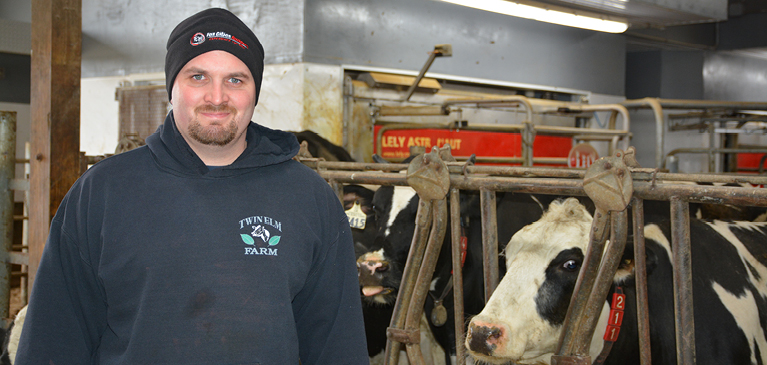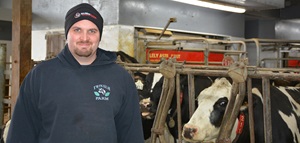
This article originally appeared in the Spring 2018 edition of Partners:

Bringing a new generation on to a dairy farm often times requires bringing in new innovation, new ideas or new technology to support the next generation. Today’s economy, coupled with the wide range of technology options on the market, require thorough evaluation and research before implementing new ideas.
For Tyler Wagner, it was automated milking systems that piqued his interest and proved to be a viable solution.
“When I told Dad I wanted to bring in robots, he thought I was crazy,” Tyler says. “But we did a lot of research and crunched the numbers and saw it could work.”
Today, the Wagners use four Lely robots to milk their herd of 240 cows in Manitowoc, Wisconsin. The transition to robots was the next progression for Tyler and his dad, Dale. Dale started the farm in the mid-1980s with 30 cows in a tie-stall barn. In 1997, they moved out of the tie stalls into freestall housing with a four-stall flat barn parlor. They had steady growth of the herd for several years including the purchase of a neighboring farm in 2010 and the addition of two more stalls in the parlor. By 2014, they were facing tough decisions – continue to invest in dairy or sell the cows.
“The parlor was old and tired,” Tyler said. “We needed to do something – either sell the cows and just do the crops or invest in the dairy. We couldn’t see letting the barn sit empty, so we started looking into our options. Robots seem to make the most sense because I would rather manage cows than people.”
Before bringing in the robots, the Wagners met with other producers who were using robots and visited farms around the Midwest to put together the system that would work best for them. They also did a great deal of cost analysis to make sure the investment would cash flow.
“We projected a $1.30/CWT labor savings using the robots, giving us a 5-year return on our investment. We are half way through the first five years and are on track to meet our goal,” Tyler says.
While the Wagners could pencil out the costs and retrofit their barn to accommodate the robots, the one uncertainty they had was the potential effect on milk production and overall cow health. Having worked to achieve production levels of 85-pounds of milk per cow, they were concerned production might dip when they transitioned to the robots.
The herd is currently at pre-robot levels with higher fat and protein components and lower somatic cell counts. The consistent production endured eliminating the use of Posilac® and moving from a total mixed ration to a partial mixed ration, with pellets fed at milking. Maintaining and even improving production levels was the important part of the cost equation allowing the Wagners to see their projected ROI.
“The biggest unexpected benefit of the robots is the increase in pregnancy rate,” Tyler adds. “Because they are not standing in a holding area or at a feed bunk they are resting more. Before the robots the cows were waiting up to an hour and a half at each milking. We are also seeing a big improvement in the cow’s feet and legs.”
The cows are not the only ones enjoying an easier lifestyle. The Wagners are too.
“Using robots is a lifestyle change for a dairy farm,” Tyler says. “When we were growing up my parents never missed one of our games or school activities. I want to be able to do the same with my kids. Last Christmas, Dad and I were able to work around Christmas dinner, rather than having to plan around milking time. It makes a big difference.”
While the robots do not eliminate the daily work on the farm – animals still need to be fed and monitored, barns cleaned, calves cared for – it does allow for more flexibility. The Wagners have reduced the number employees from six to two with some part-time help.
The addition of the robots has become a pivotal point in the legacy of the Wagner’s family farm. Both Dale and Tyler took the opportunity during the transition to begin the overall succession planning of the dairy and their custom harvesting business.
“Dad brought me into the harvesting business as a partner in 2007, two years after I graduated high school. I became a partner in the dairy in 2015 and in 2017 the dairy bought the harvesting company,” Tyler explains.
The Wagners work closely with Laurie Schetter, senior financial services officer at GreenStone’s Manitowoc branch. Having a good relationship with Laurie has helped make the business and farm transitions easier.
“When we visit with Laurie, we generally present her with three ideas and plans on how they will work,” Dale says. “She will take the plans back to the office, meet with her team and then give us an idea of what each would look like. We like to plan conservatively and be surprised when things turn out better than we expected, rather than the other way around. Laurie helps us make those kinds of decisions.”
Transitioning to the robots has created other opportunities on the farm and instilled a sense of optimism for the Wagners.
“We are always thinking about where the next robot can go,” Tyler says.
To read more articles like this, check out the online version of this year’s spring edition of Partners!
https://issuu.com/greenstonefcs/docs/gs_partners_springweb/6

Bringing a new generation on to a dairy farm often times requires bringing in new innovation, new ideas or new technology to support the next generation. Today’s economy, coupled with the wide range of technology options on the market, require thorough evaluation and research before implementing new ideas.
For Tyler Wagner, it was automated milking systems that piqued his interest and proved to be a viable solution.
“When I told Dad I wanted to bring in robots, he thought I was crazy,” Tyler says. “But we did a lot of research and crunched the numbers and saw it could work.”
Today, the Wagners use four Lely robots to milk their herd of 240 cows in Manitowoc, Wisconsin. The transition to robots was the next progression for Tyler and his dad, Dale. Dale started the farm in the mid-1980s with 30 cows in a tie-stall barn. In 1997, they moved out of the tie stalls into freestall housing with a four-stall flat barn parlor. They had steady growth of the herd for several years including the purchase of a neighboring farm in 2010 and the addition of two more stalls in the parlor. By 2014, they were facing tough decisions – continue to invest in dairy or sell the cows.
“The parlor was old and tired,” Tyler said. “We needed to do something – either sell the cows and just do the crops or invest in the dairy. We couldn’t see letting the barn sit empty, so we started looking into our options. Robots seem to make the most sense because I would rather manage cows than people.”
Before bringing in the robots, the Wagners met with other producers who were using robots and visited farms around the Midwest to put together the system that would work best for them. They also did a great deal of cost analysis to make sure the investment would cash flow.
“We projected a $1.30/CWT labor savings using the robots, giving us a 5-year return on our investment. We are half way through the first five years and are on track to meet our goal,” Tyler says.
While the Wagners could pencil out the costs and retrofit their barn to accommodate the robots, the one uncertainty they had was the potential effect on milk production and overall cow health. Having worked to achieve production levels of 85-pounds of milk per cow, they were concerned production might dip when they transitioned to the robots.
The herd is currently at pre-robot levels with higher fat and protein components and lower somatic cell counts. The consistent production endured eliminating the use of Posilac® and moving from a total mixed ration to a partial mixed ration, with pellets fed at milking. Maintaining and even improving production levels was the important part of the cost equation allowing the Wagners to see their projected ROI.
“The biggest unexpected benefit of the robots is the increase in pregnancy rate,” Tyler adds. “Because they are not standing in a holding area or at a feed bunk they are resting more. Before the robots the cows were waiting up to an hour and a half at each milking. We are also seeing a big improvement in the cow’s feet and legs.”
The cows are not the only ones enjoying an easier lifestyle. The Wagners are too.
“Using robots is a lifestyle change for a dairy farm,” Tyler says. “When we were growing up my parents never missed one of our games or school activities. I want to be able to do the same with my kids. Last Christmas, Dad and I were able to work around Christmas dinner, rather than having to plan around milking time. It makes a big difference.”
While the robots do not eliminate the daily work on the farm – animals still need to be fed and monitored, barns cleaned, calves cared for – it does allow for more flexibility. The Wagners have reduced the number employees from six to two with some part-time help.
The addition of the robots has become a pivotal point in the legacy of the Wagner’s family farm. Both Dale and Tyler took the opportunity during the transition to begin the overall succession planning of the dairy and their custom harvesting business.
“Dad brought me into the harvesting business as a partner in 2007, two years after I graduated high school. I became a partner in the dairy in 2015 and in 2017 the dairy bought the harvesting company,” Tyler explains.
The Wagners work closely with Laurie Schetter, senior financial services officer at GreenStone’s Manitowoc branch. Having a good relationship with Laurie has helped make the business and farm transitions easier.
“When we visit with Laurie, we generally present her with three ideas and plans on how they will work,” Dale says. “She will take the plans back to the office, meet with her team and then give us an idea of what each would look like. We like to plan conservatively and be surprised when things turn out better than we expected, rather than the other way around. Laurie helps us make those kinds of decisions.”
Transitioning to the robots has created other opportunities on the farm and instilled a sense of optimism for the Wagners.
“We are always thinking about where the next robot can go,” Tyler says.
To read more articles like this, check out the online version of this year’s spring edition of Partners!
https://issuu.com/greenstonefcs/docs/gs_partners_springweb/6


